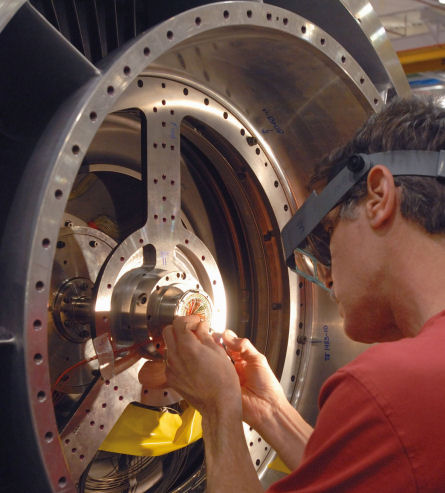MTU Aero Engines which manufactures and repairs commercial and military engines is applying technology from Europe's CLEAN environmental aero-engine research programme to Pratt & Whitney's geared turbofan (GTF).
The German company has developed a high-speed low-pressure turbine based on its CLEAN design for the GTF demonstrator engine in final assembly at P&W.
Details of the design challenges posed by the GTF's increased LP spool speed were presented by MTU Aero Engines at a recent European conference in Berlin.
P&W's other GTF partners are Avio for the fan drive gear system, Volvo Aero for the turbine exhaust case and Goodrich for the slimline nacelle.
|
|---|
P&W has completed assembly of its geared turbofan demonstrator |
P&W plans to begin ground tests in November under a programme to demonstrate the GTF's technology readiness by the end of 2008, to support entry into service as early as 2012. The programme includes four to five months of flight tests on P&W's Boeing 747 engine testbed, beginning in mid-2008.
The GTF is designed to reduce specific fuel consumption 12% over current turbofans by increasing bypass ratio to 10-12. Reducing fan pressure ratio requires a large diameter, and a geared fan allows tip speed to be reduced for lower noise.
The reduction gearbox also allows the LP compressor and turbine speed to be increased, to extract more work from fewer stages and airfoils, reducing weight.
"Weight reductions of the low-pressure compressor and turbine will compensate for the gear mechanism mass. We think GTF is the answer to the environmental challenge that is out there," says MTU's chief engineer for next-generation systems integration Claus Riegler.
The 31,000shp (23,100kW) fan drive gearbox in the 30,000lb thrust-(134kN) class GTF demonstrator provides a 3:1 reduction. This allows the 1.9m (75in)-diameter, 18-blade fan to run at two-thirds the speed of a conventional engine while the low-pressure spool runs two and a half times faster than normal, says Bob Saia, P&W vice-president, next-generation product family.
While the demonstrator uses the high-pressure core of the existing PW6000 turbofan, the high-speed LP compressor and turbine have been designed specifically for the GTF by P&W and MTU respectively.
Compared with the similarly sized IAE V2500, 900 airfoils have been removed in the LPT and 600 in the LPC, a reduction in blade count of 60. "Decoupling the fan allows the turbine to run at a more efficient, higher speed and do more work with fewer parts," says Saia.
MTU says its CLEAN high-speed LPT, on which the GTF design is based, has three stages compared with five in the V2500, for a similar power output. The individual disks are heavier, but the overall LPT is shorter and lighter.
Design features include a cutback tip shroud to reduce centrifugal forces in the lightweight titanium-aluminide airfoil and increase in airfoil cross-section from tip to root to reduce stress in the blade and a blade root designed to reduce loads at the disk rim.
After ground runs in Florida, flight tests of the GTF on P&W's 747 testbed will investigate its performance and operability. The fan-drive and thermal-management systems will be tested in flight conditions including zero-g and windmilling, as well as different manoeuvre loads and deflections.
Source: Flight International
























